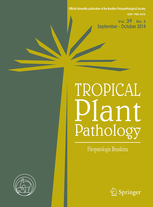Ver ítem
- xmlui.general.dspace_homeCentros e Institutos de InvestigaciónCIAP. Centro de Investigaciones AgropecuariasInstituto de Patología VegetalArtículos científicosxmlui.ArtifactBrowser.ItemViewer.trail
- Inicio
- Centros e Institutos de Investigación
- CIAP. Centro de Investigaciones Agropecuarias
- Instituto de Patología Vegetal
- Artículos científicos
- Ver ítem
Molecular characterization of effector protein SAP54 in Bellis virescence phytoplasma (16SrIII-J)
Resumen
Phytoplasmas are wall-less bacteria with a parasitic lifestyle responsible for numerous plant diseases worldwide. Since the introduction of next generation sequencing technologies, genome wide studies of these pathogens are flourishing and a handful of phytoplasma genomes are available in public databases. In South America, phytoplasmas from the 16SrIII group (X-disease) are the most widely distributed, but only one draft genome from a 16SrIII-J
[ver mas...]
Phytoplasmas are wall-less bacteria with a parasitic lifestyle responsible for numerous plant diseases worldwide. Since the introduction of next generation sequencing technologies, genome wide studies of these pathogens are flourishing and a handful of phytoplasma genomes are available in public databases. In South America, phytoplasmas from the 16SrIII group (X-disease) are the most widely distributed, but only one draft genome from a 16SrIII-J phytoplasma-infected periwinkle plant has been generated (phytoplasma Vc33). Here, in grafting experiments, we characterized the phenotypic signatures of an Argentinian daisy-derived isolate of a 16SrIII-J phytoplasma (Bellis virescence phytoplasma) infecting periwinkle. Moreover, we applied a pipeline for genome-wide annotation of the Vc33 genome and identified the effector protein SAP54. We then employed the obtained data to amplify, clone, sequence and characterize a SAP54 orthologue protein from the Bellis virescence phytoplasma. Structural analyses suggest that the identified SAP54 effector is highly conserved. The results gathered here could provide the basis for reverse genetics experiments using 16SrIII-J SAP54 proteins to assess their eventual role in pathogenesis.
[Cerrar]

Fuente
Tropical Plant Pathology 44 (4) : 392-397 (August 2019)
Fecha
2019-06-03
Editorial
Springer
ISSN
1983-2052
Formato
pdf
Tipo de documento
artículo
Palabras Claves
Derechos de acceso
Restringido
 Excepto donde se diga explicitamente, este item se publica bajo la siguiente descripción: Creative Commons Attribution-NonCommercial-ShareAlike 2.5 Unported (CC BY-NC-SA 2.5)
Excepto donde se diga explicitamente, este item se publica bajo la siguiente descripción: Creative Commons Attribution-NonCommercial-ShareAlike 2.5 Unported (CC BY-NC-SA 2.5)

